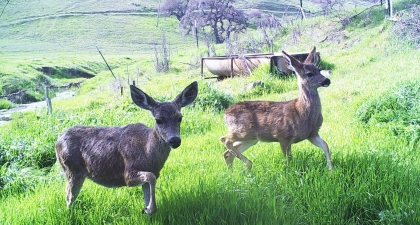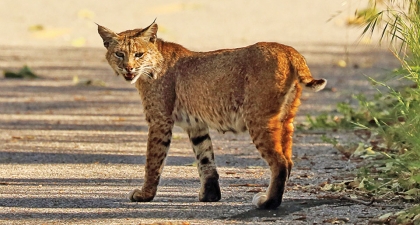The alligator lizard’s name comes from its bony scales, large head, elongated body, and powerful jaw. These lizards have short legs and move with a snake-like, undulating motion by using their front legs to pull their belly along the ground. Alligator lizards have very long tails which can easily break off when threatened, a defense behavior exhibited by many lizard species. They can be found in a variety of California habitats, including grassland, chaparral, and oak woodlands. Alligator lizards usually mate in the spring and lay eggs that hatch in late summer or early fall.
The California newt is also known as the orange-bellied newt. This native amphibian only lives in (endemic to) California and is found across the state's coasts and coast ranges. Terrestrial adults are orange-brown to dark brown above, with pale yellow or orange bellies. California newts secrete a powerful neurotoxin, called tetrodotoxin, from their skin to repel predators! Look for these large, stocky salamanders crawling across the ground.
The California tiger salamander is an endangered amphibian that thrives in Sierra Vista Open Space Preserve, thanks to its ponds and grasslands. These 7-to 8-inch-long salamanders are dark brown or black with white or yellow spots. They have small, protruding eyes, and wide mouths that appear to be smiling. During the dry months, the California tiger salamander lives underground in burrows made by other animals, such as ground squirrels. When the wet season begins, they migrate to ponds to breed. You are most likely to spot one during a rainy night.
Garter snakes are slender, medium-sized snakes found throughout most of California, including the Santa Clara Valley. With a sharp eye, you might be able to see one quickly slithering through the grass, although they are well camouflaged with their vertical stripes of yellow, red, black, and/or white. As a cold-blooded animal, the garter snake keeps its body temperature warm by sunbathing during the day and returning underground when the sun goes down. They give birth to live young between July and September. These snakes eat a wide variety of prey, including small mammals, amphibians, insects, and worms - while they are food for mammals, birds of prey, and larger snakes!
Rattlesnakes are the only type of venomous snake found in the Santa Clara Valley. You are most likely to spot one on a hot day when they may be sunbathing on a trail or exposed rock. They have triangular heads and chunky olive or tan striped bodies. Their tails have a set of rattles at the end, made of keratin, the same material found in your fingernails. Snakes vibrate the rattles when alarmed and may also hiss. Be warned: Rattlesnake venom is highly toxic. Rattlesnakes eat a variety of small mammals, lizards, and birds. They hibernate during the winter.
Red-legged frogs are 2 to 5 inches long, brown or olive-colored, with red on parts of the belly and legs. These frogs are classified as “threatened” under the federal Endangered Species Act due primarily to the loss of wetland habitat, although they also face threats from non-native bullfrogs. They are found in Sierra Vista and Rancho Cañada del Oro open space preserves, but are active primarily at night so visitors are unlikely to spot them. During their winter breeding season, females can lay as many as 3,000 eggs in shallow water. After hatching, the tadpoles mature — or metamorphose — into frogs about five months later.
Western fence lizards are about 3 inches long with bits of blue on their bellies. Males are often observed doing a push-up like display to defend their territory and to attract females. Lizards are a staple food of snakes and birds of prey like hawks. Western fence lizards, a subspecies of the coast range fence lizard, have an interesting relationship with Lyme disease: Their blood contains a protein that kills the bacteria that causes Lyme disease. However, the lizards are a key host for ticks that carry Lyme disease, so there are more ticks in western fence lizard habitat.
The Western pond turtle lives in wetlands, ponds, and streams and can often be spied in the spring, summer, and fall sunbathing on a rock or log. It may spend the winter buried in a shallow dugout in the woods. They are approximately 5-6 inches long and olive or brown colored. The Western pond turtle is found from Oregon to Baja California primarily west of the Sierra Nevada, although they have lost habitat due to development and the arrival of non-native bullfrogs and turtles such as the red-eared slider. They eat worms, aquatic plants, small fish, and insects.
The yellow-eyed ensatina is an orange-brown salamander that is about 5 inches long. These salamanders have no lungs — instead they breathe through their skin and mouth. That’s why you are mostly likely to spot them in moist spots under fallen branches or in tree cavities, although they may be on a trail following a rain. Providing homes for creatures like ensatinas is one reason it is important to leave downed trees undisturbed. They eat worms, beetles, spiders, and a variety of other invertebrates. Females lay around 12 eggs on land in the late spring, which they guard until the babies emerge in the fall.

























